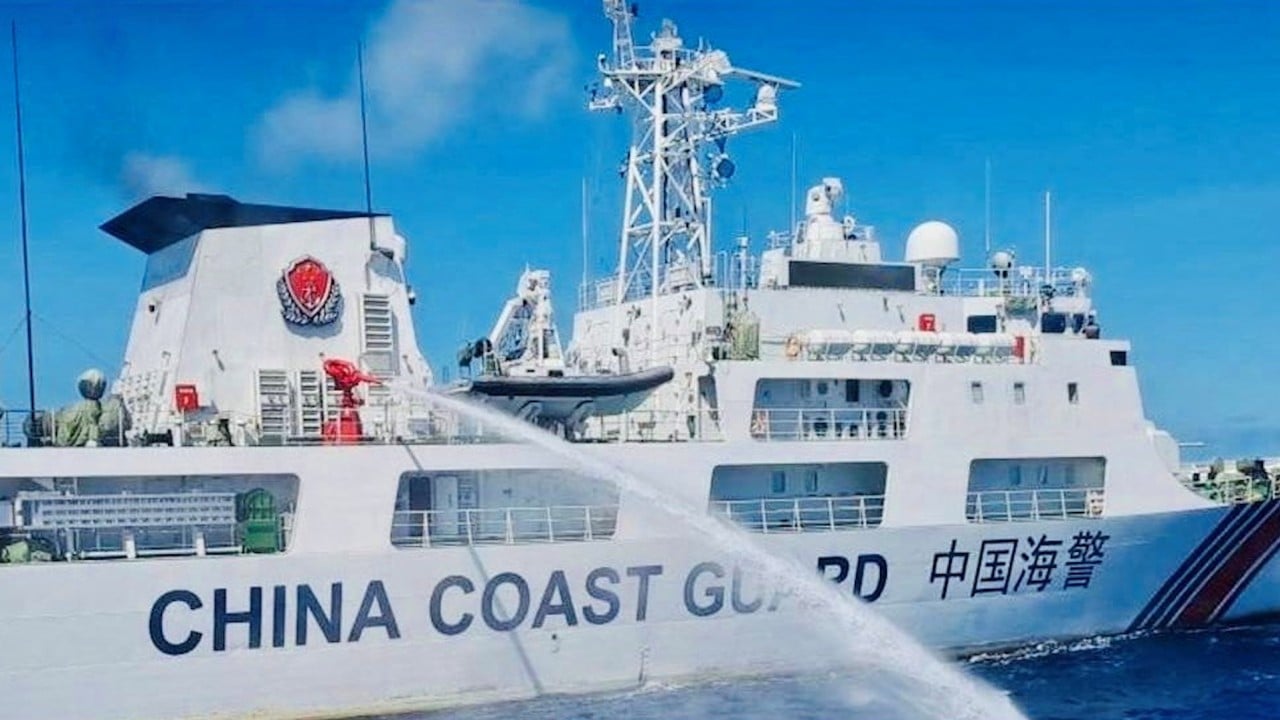
South China Sea: Beijing and Manila trade accusations over ‘provocative’ ship collisions near disputed atoll
- Beijing says Philippine coastguard ship ‘deliberately’ ran into fishing boat, while Manila blames Chinese side for earlier crash
- It is the latest clash to occur near the contested Second Thomas Shoal, which has become a flashpoint for tensions between the countries
“The behaviour of the Philippine side is a serious violation of the international rules on collision avoidance at sea and threatens the safety of navigation, while our operation is professional, legitimate and lawful, and the responsibility lies entirely with the Philippine side,” the Chinese coastguard said.
China drives away Philippine gunboat near disputed Scarborough Shoal
In a separate statement, the Philippine National Security Council accused the Chinese side of causing the Sunday morning collision with the Unaiza May 2 resupply boat, which is contracted by the Philippine military.
However, another Philippine resupply ship reached the shoal to bring supplies to troops and personnel stationed there, the statement said.
It added that the National Task Force for the West Philippine Sea “condemns in the strongest degree the latest dangerous, irresponsible and illegal actions” of the Chinese coastguard.
The incident drew criticism from some Western countries, including the US – a treaty ally to the Philippines.
American ambassador to the Philippines MaryKay Carlson described China’s actions as “putting the lives of Filipino service members at risk”.
“We stand with our friends, partners and allies in protecting sovereignty and in support of a Free and open indoPacific,” Carlson wrote on X, the social media platform formerly known as Twitter.
The US State Department on Sunday described China’s actions as “dangerous” and “unlawful”.
Canada condemned what it called “unjustified” actions by China.
“Continuing acts of intimidation and coercion undermine safety, stability, and security across the region, and increase the risk of miscalculation,” the Canadian embassy said in a statement on X.
Germany and the European Union also voiced their concerns.
“These incidents, their repetition and intensification are dangerous and very disturbing,” EU ambassador to the Philippines Luc Veron wrote on X, adding that countries should fully observe international laws in the waters.
The exchange of accusations came hours after Beijing announced early Sunday morning that it had “lawfully” blocked Philippine vessels transporting “illegal construction materials” to a warship “illegally grounded” in the shoal.
The Second Thomas Shoal, known as Renai Jiao in China and Ayungin Shoal in the Philippines, has become a flashpoint for tensions between Beijing and Manila in the strategically important South China Sea.
Earlier this month, Manila accused Beijing of carrying out a “dangerous manoeuvre” when a Chinese coastguard vessel came “as close as one metre” (3.3 feet) to a Philippine coastguard ship that tried to resupply the Sierra Madre vessel on the shoal. The Philippines said it “successfully” carried out the mission, while Beijing urged Manila to stop further “provocations”.
China claims “indisputable sovereignty” over the Second Thomas Shoal and has repeatedly restricted resupply missions of construction materials by Manila, which considers the shoal – located about 105 nautical miles from the Philippines – part of its exclusive economic zone under the United Nations Convention on the Law of the Sea.
The two sides have increasingly clashed over disputed waters in the South China Sea in recent months, particularly as Philippine President Ferdinand Marcos Jnr, who took office in June last year, has hardened his position over the maritime dispute and strengthened his country’s alliance with Washington.
‘Unapproved’ Philippine vessels in South China Sea warned by Chinese coastguard
To counter what it views as Beijing’s aggression in the South China Sea, the Philippines has published videos and photos of incidents involving Chinese ships and forces. It has also invited domestic and foreign journalists to monitor its resupply missions.
The latest incident highlighted the risks of confrontations in the waterway, through which goods worth between US$3 trillion and US$5 trillion are shipped every year.
Last month, Beijing placed floating barriers near Scarborough Shoal, known as Huangyan Island in Chinese, another South China Sea atoll, in what it said was a necessary measure to stop Philippine fishermen from entering the shoal’s lagoon.
The Philippine Coast Guard later released photos and videos, saying it had removed the buoys, a claim soon disputed by Beijing, which insisted it took away the barrier “voluntarily”.
Additional reporting by Reuters


